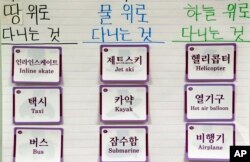Hilda Maldonado is an evangelist for bilingual education. As head of multilingual programming for the Los Angeles Unified School District, she welcomed California's vote last fall to repeal an almost two-decade mandate for English-only classes in public schools.
Her district's 640,000-plus students collectively speak 93 languages. Maldonado said, "Forty-nine percent of the students in this district come with a second language. We should see that as a wealth of our state and not as something we must eliminate."
California voters last November overwhelmingly approved Proposition 58. Now, Maldonado and other Californians are scrambling to prepare for the initiative, which takes effect in July.
More control for schools
As The Los Angeles Times explains, the measure gives communities and their schools more control over whether to offer bilingual education and, if they do, which language to choose besides English. Prop 58 still requires that all students develop proficiency in English.
While the California Board of Education develops guidelines and accountability measures, Maldonado said school districts are doing research, working on credentialing bilingual teachers and informing parents about how to proceed. Launching a bilingual program starts with a show of interest by parents of at least 20 students in one grade level or 30 students schoolwide, the California Association for Bilingual Education says on its website.
These efforts most likely will be scrutinized. California serves as a laboratory on U.S. immigration, with more foreign-born residents — almost 10.5 million, or over one in four — than any other state.
In 1998, California became the first U.S. state to prohibit bilingual education amid concern that newcomer students weren't adequately learning English. That worry persists among opponents of Proposition 58. But proponents say it cuts "the bureaucratic red tape around multilingual education [that] is harmful to students in a global economy, where the most sought after employees speak more than one language," according to The L.A. Times.
In the last academic year, among California's 6.2 million kindergarten-through-12th-grade students, nearly a quarter were classified as English-language learners. Most speak only Spanish.
More in L.A. district
The concentration of English-language learners is even higher in the Los Angeles district, at almost half. Again, Spanish is most common. Other predominant languages include Korean, Armenian, Tagalog, Cantonese, Arabic, Vietnamese and Russian.
But, because of the earlier restrictions, few California public schools — not even 5 percent — currently offer multilingual programs, The Times reported. Those schools had to get waivers.
One of the rare ones is Cahuenga Elementary School, in central Los Angeles' Koreatown neighborhood. There, Wonnie Pak teaches third-graders in both English and Korean, trying to incorporate fun into their lessons. They've learned songs in Korean, for instance.
The teacher calls the human brain "an incredible tool" and encourages language instruction for students of all ages.
"If you give them the opportunity, then they will learn it, no matter how young or how old," she said. "Like in Europe. They speak so many languages. Why can't we? Why do we have to just only speak English?"
Arturo Vargas, executive director of the National Association of Latino Elected and Appointed Officials, suggests bilingual education aids students and also preserves vulnerable languages.
"Latino children are losing their Spanish and speaking only in English," he said. "I mean, the English language is not under threat. What is actually threatening is not having enough knowledge about all the languages spoken in the United States."
Other state bans
Two other states — Arizona and Massachusetts — prohibit bilingual education, according to the National Association of State Legislatures (NCSL).
In 2000, Arizonans voted to require English-only classes except for foreign language training, giving pupils classified as English learners up to a year for structured immersion. In 2002, Massachusetts approved a similar law. Though both states offer waivers, the process may be "difficult for parents to navigate, especially for those parents with limited English skills themselves," NCSL education policy specialist Matthew Weyer said in an email.
Obstacles to bilingual education can include school financing, cultural resistance and, Weyer noted, finding qualified and experienced bilingual teachers.
California is one of at least 20 states in which local school districts can award a Seal of Biliteracy to high school graduates proficient in at least two languages.
Carol Guensburg contributed to this report produced by VOA's Spanish service.











